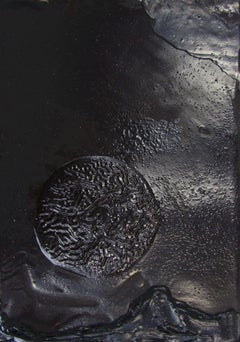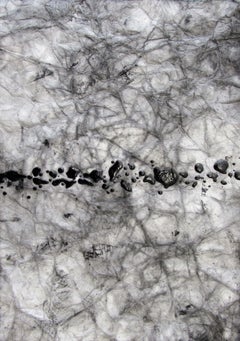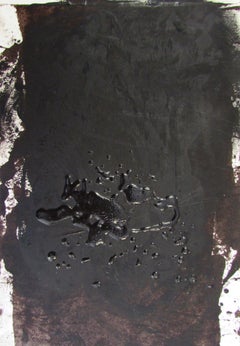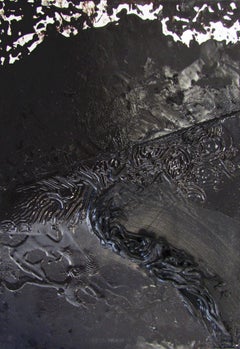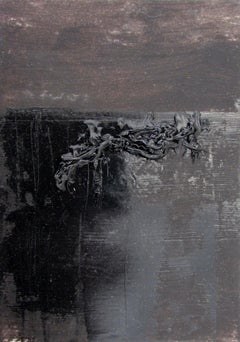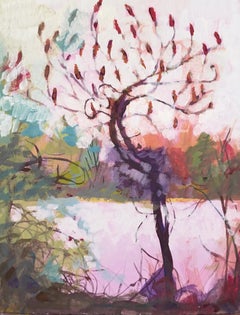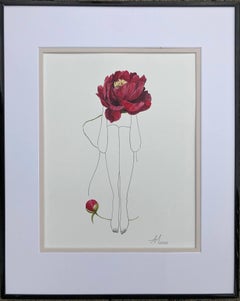Oil Abstract Drawings and Watercolors
to
5
Overall Width
to
Overall Height
to
5
3
2
5
96,338
9
7
7
7
165
39
35
16
11
4
5
Medium: Oil
Artist: Zsolt Berszán
Untitled 07 - Contemporary, Monochrome, Abstract, Black, Organic, Small, Drawing
Located in Baden-Baden, DE
Untitled 07, 2015 - 2016
Mixed technique: oil paint, adhesive on paper
(Signed on reverse, Framed)
8.26 H x 5.9 W in
21 H x 15 W cm
Zsolt Berszán’s work speaks of repulsion and fasc...
Category
2010s Abstract Oil Abstract Drawings and Watercolors
Materials
Paper, Adhesive, Oil
Untitled 02 - Contemporary, Abstract, Gray, Organic, Small, Drawing
Located in Baden-Baden, DE
Untitled 02, 2015 - 2016
Mixed technique: oil paint, adhesive on paper
(Signed on reverse, Framed)
8.26 H x 5.9 W in
21 H x 15 W cm
Zsolt Berszán’s work speaks of repulsion and fasc...
Category
2010s Minimalist Oil Abstract Drawings and Watercolors
Materials
Paper, Adhesive, Oil
Untitled 04 - Contemporary, Abstract, Black, Organic, Small, Drawing
Located in Baden-Baden, DE
Untitled 04, 2015 - 2016
Mixed technique: oil paint, adhesive on paper
(Signed on reverse, Framed)
8.26 H x 5.9 W in
21 H x 15 W cm
Zsolt Berszán’s work...
Category
2010s Abstract Oil Abstract Drawings and Watercolors
Materials
Paper, Adhesive, Oil
Untitled 08 - Contemporary, Abstract, Black, Organic, Small, Drawing
Located in Baden-Baden, DE
Untitled 08, 2015 - 2016
Mixed technique: oil paint, adhesive on paper
(Signed on reverse, Framed)
8.26 H x 5.9 W in
21 H x 15 W cm
Zsolt Berszán’s work speaks of repulsion and fasc...
Category
2010s Abstract Oil Abstract Drawings and Watercolors
Materials
Paper, Adhesive, Oil
Untitled 06 - Contemporary, Monochrome, Abstract, Black, Organic, Small, Drawing
Located in Baden-Baden, DE
Untitled 06, 2015 - 2016
Mixed technique: oil paint, adhesive on paper
(Signed on reverse, Framed)
8.26 H x 5.9 W in
21 H x 15 W cm
Signed on reverse
Zsolt Berszán’s work speaks of...
Category
2010s Minimalist Oil Abstract Drawings and Watercolors
Materials
Paper, Adhesive, Oil
Related Items
Sumac, colorful Abstract Impressionist landscape gouache
Located in New York, NY
Sandy Litchfield found peace and inspiration in regular solitary walks through nature throughout the pandemic. Her most recent body of work diaristically documents her constitutional...
Category
2010s Abstract Impressionist Oil Abstract Drawings and Watercolors
Materials
Paper, Gouache
Red peony - line drawing woman figure with flower
By Mila Akopova
Located in Fort Lee, NJ
Interior design paintings. The work was done with ink and watercolor on watercolor paper 300g. The work is 11 by 15 inches in size framed (black) with a styrene face on a double mat ...
Category
2010s Minimalist Oil Abstract Drawings and Watercolors
Materials
Paper, Ink, Watercolor
"NY Street Signs" Mid-20th Century WPA 1938 Modernist Abstract Realism Pop Art
By Stuart Davis
Located in New York, NY
"NY Street Signs" Mid-20th Century WPA 1938 Modernist Abstract Realism Pop Art
Stuart Davis (American, 1892-1964) "Street Signs" Modernist gouache and traces of pencil on paper in the proto-pop art style Davis is celebrated for, 1938, signed to lower right, framed. Image: 11 1/4 x 15 1/4 inches. Frame by Bark: 18 1/2 x 22 inches.
LITERATURE: A, Boyajian, M. Rutkowski, Stuart Davis, A Catalogue Raisonne, Vol. 2, New Haven, Connecticut, 2007, vol. II, p. 632, no. 1232, illustrated.
EXHIBITIONS: ACA Galleries, New York American Artists' Congress: Group Exhibition of Paintings and Sculpture, Dec. 3-16, 1939 (SDAB I, 12/3/39, p. 129). Outlines Gallery, Pittsburgh, Stuart Davis, Mar. 3-16, 1946. Coleman Art Gallery, Philadelphia, 5 Prodigal Sons: Former Philadelphia Artists: Ralston Crawford, Stuart Davis, Charles Demuth, Julian Levi, Charles Sheeler, Oct 4 - 30, 1947 (pamphlet), no. 12.
PROVENANCE: The artist; Mr. and Mrs. Frank Bowles, New York, Apr. 3, 1956; thence by descent, Private Collection, New York.
NOTES: According to the Catalogue Raissonne, "the title 'Street Signs' is recorded in the artist's account books...
Category
1930s American Modern Oil Abstract Drawings and Watercolors
Materials
Paper, Gouache, Pencil
$125,000
H 18.5 in W 22 in D 1 in
Unique painting on paper, hand signed by Minimalist pioneer Lyman Kipp, Framed
Located in New York, NY
Lyman Kipp
Unique painting on paper done with paint roller, 1970
Ink roller painting on paper
Signed and dated in ink by Lyman Kipp on the lower right
Frame included: elegantly frame...
Category
1970s Minimalist Oil Abstract Drawings and Watercolors
Materials
Ink, Oil
$3,500
H 17.5 in W 15.25 in D 1.75 in
"Chimneys at Dusk", Small Pastel San Francisco Abstract Urban Landscape
Located in Soquel, CA
Abstracted Bay Area skyline against a pink sunset creates beautiful and soft geometries in this small pastel urban landscape by San Francisco artist Chris...
Category
1990s Abstract Impressionist Oil Abstract Drawings and Watercolors
Materials
Paper, Pastel, Watercolor
$520 Sale Price
20% Off
H 16.5 in W 17.13 in D 0.75 in
Original-Golden Summer-UK Awarded Artist, British School, Exhibition Collection
Located in London, GB
Shizico spent three days painting this plein air in her sunlit garden. She applied 550 Ture Gold paint and Van Gogh Yellow creating a stunning backdrop which served as the canvas for...
Category
2010s Abstract Expressionist Oil Abstract Drawings and Watercolors
Materials
Gold
$619
H 16.54 in W 11.82 in D 0.04 in
Minimalist painting on paper by pioneering sculptor Lyman Kipp, signed, Framed
Located in New York, NY
Lyman Kipp
Untitled Minimalist painting on paper, 1981
Oil paint on paper
Signed and dated 1981 on the front
Floated and framed in the original vintage frame under UV plexiglass
Meas...
Category
1980s Minimalist Oil Abstract Drawings and Watercolors
Materials
Ink, Oil
Field Study #749
Located in Houston, TX
Terrell James
Field Study #749, 2020
Oil on vellum
20 x 16 in (50.8 x 40.6 cm)
Category
21st Century and Contemporary Abstract Oil Abstract Drawings and Watercolors
Materials
Oil, Vellum
Flat Top Mountain - Abstract Geometric Landscape
By Erle Loran
Located in Soquel, CA
Gorgeous burst of blue behind a flat top mountain with splashes of orange in this abstract geometric landscape by Erle Loran (American, 1905-1999). Signed and dated lower right "Erle...
Category
1970s Abstract Geometric Oil Abstract Drawings and Watercolors
Materials
Watercolor, Archival Paper, Rag Paper
$2,800 Sale Price
20% Off
H 29.13 in W 37.13 in D 0.75 in
Abstract Cityscape Watercolor
By Les Anderson
Located in Soquel, CA
Abstract cityscape watercolor with loosely defined landscape elements and geometric shapes by Les (Leslie Luverne) Anderson (American, 19...
Category
1980s Abstract Expressionist Oil Abstract Drawings and Watercolors
Materials
Paper, Watercolor
Mid Century Abstract Vertical Sunset
Located in Soquel, CA
Abstract watercolor fragment of a sunset over a field by Irene Pattinson (American, 20th Century). Tag on verso reads "Miller Fine Art / The Estate of Irene Pattinson". Unsigned. Acq...
Category
1960s Abstract Expressionist Oil Abstract Drawings and Watercolors
Materials
Watercolor, Tissue Paper
$308 Sale Price
35% Off
H 14.5 in W 9.5 in D 0.13 in
"Colorful Geometric Abstraction, " Simon Samsonian, Armenian Artist
Located in New York, NY
Simon Samsonian (1912 - 2003)
Colorful Geometric Abstraction, 1981
Oil on paper
16 x 22 inches
Signed and dated lower right
Provenance:
Estate of the artist
This survivor of the Armenian genocide wound up in a Cairo orphanage in 1927. He rose to fame as one of Egypt’s great modernists, but after moving to Long Island late in life he withdrew into anonymity. Now his compelling story is being told. Art historians are finally beginning to realize that the power of abstraction in its early years was a zeitgeist not limited to the major European centers of the avant-garde — Paris, Munich, and Moscow — but one that quickly rippled to major cities throughout the world. Within a few decades that original shock of a new vision had inspired thousands of artists from different cultures — particularly those the Middle East — whose translations were not slavish imitations of works by seminal figures like Picasso, Braque, Malevich, and Kandinsky but creative variants colored by their respective cultures.
This essay focuses on an extraordinary Armenian artist, his harrowing survival of the genocide, his rise to fame in Cairo, and his creation of a unique style of abstraction. Art historians have typically formed a chorus that teaches the history of abstraction like this: Just before and during the World War I era, several avant-garde artists emerged to create shockingly different new forms by which artists could express themselves. In Paris, Picasso and Braque broke out with cubism, quickly followed by Mondrian. In Moscow, Malevich created Suprematism, the ultimate hard-edge geometric abstraction. And in Munich, Kandinsky emerged as the father of Abstract Expressionism. Within these few short years a zeitgeist was sensed throughout the art world. American pioneers, too — particularly Stanton Macdonald-Wright and Morgan Russell — felt this explosive freedom of expression. When Europe was recovering after World War I it became clear that Paris would retain its title as capitol of the art world, lasting through the Roaring Twenties and even through the Great Depression. But the end of World War II changed everything. A parallel war had been won by a group of irascible young Abstract Expressionists in New York — led by Pollock, Rothko, DeKooning, and Kline. No sooner had Paris been liberated from the Germans than Picasso, Matisse, Breton, and Duchamp surrendered to the Americans. From that point on New York would be the epicenter of the art world.
But a lens that focuses myopically on the war between the avant-garde of Paris and New York misses the wider narrative of multiple aesthetic modernities that developed in the several decades following World War I. For Armenian artists the matter is even more complex owing to the genocide of 1915 where more than 1.5 million people — seventy-five percent of Armenians in the Ottoman Empire — were massacred. Those not shot on the spot were sent on death marches through the Mesopotamian desert without food or water. Frequently, the marchers were stripped and forced to walk naked under the scorching sun until they dropped dead.
As a child Samsonian witnessed the murder of his parents and most of the members of his family. Soon thereafter, his older sister, Anahid, quickly shepherded him into a line of children being rescued by Greek nuns. But they became separated and he lost her, too. He was sent to a Greek orphanage in Smyrna (now Izmir), on Turkey’s west coast. Because he only knew his first name, the orphanage gave him a last name based on the place where they found him — Samsun — a major port on Turkey’s north coast on the Black Sea. His birth date was unknown, too. According to Samsonian’s vague recollections he assumed he was about three or four years old at the onset of the genocide, which would place his birth year in 1911 or 1912. In 1922, when Samsonian was about 10, the Turks ended their war with the Greeks by putting Smyrna to the torch in what has been called the “Catastrophe of Smyrna.” Once again, the child was on the run, escaping the fire and slaughter. He found temporary refuge in Constantinople, but within a year that major port would fall to the Turks, too, and become renamed as Istanbul. This time, Samsonian was whisked away to an orphanage in Greece founded by the American charity, Near East Relief — which is credited with saving so many Armenian orphans that the American historian Howard M. Sachar said it “quite literally kept an entire nation alive.
Any understanding of Samsonian’s approach to modernism requires careful consideration of the impact of his early years because his art is inseparable from the anguish he experienced. In 1927, when he was a teenager, he was transferred to Cairo, Egypt, then a cosmopolitan city hosting a sizable portion of the Armenian diaspora. There he lived with thirty-two other children on the top floor of the Kalousdian Armenian School. Upon graduating in 1932 he won a scholarship to attend the Leonardo da Vinci Art Institute — an Italian art school in Cairo — where he won first prize in final examinations among one hundred students. He found work with an Armenian lithographic printer and he returned to the Kalousdian Armenian School to teach drawing. In 1939 he married one of his students, Lucy Guendimian.
The Cairo in which Samsonian matured as an artist was home to many prominent art collectors after World War I. In this receptive environment Samsonian exhibited widely and won many awards. Beginning in 1937 and for the next thirty years he exhibited annually at the prestigious Le Salon du Caire hosted by the Société les Amis de l’Art (founded in 1921). After World War II he hit his stride as a modernist in Cairo, counting among his peers other artists of the Armenian diaspora such as Onnig Avedissian, Achod Zorian, Gregoire Meguerdichian, Hagop Hagopian...
Category
1980s Abstract Geometric Oil Abstract Drawings and Watercolors
Materials
Paper, Oil
Oil abstract drawings and watercolors for sale on 1stDibs.
Find a wide variety of authentic Oil abstract drawings and watercolors available on 1stDibs. While artists have worked in this medium across a range of time periods, art made with this material during the 21st Century is especially popular. If you’re looking to add Abstract drawings and watercolors created with this material to introduce a provocative pop of color and texture to an otherwise neutral space in your home, the works available on 1stDibs include elements of red, blue, orange, green and other colors. There are many well-known artists whose body of work includes ceramic sculptures. Popular artists on 1stDibs associated with pieces like this include Claude Tétot, Fieroza Doorsen , Anya Spielman, and Zsolt Berszán. Frequently made by artists working in the Abstract, Contemporary, all of these pieces for sale are unique and many will draw the attention of guests in your home. Not every interior allows for large Oil abstract drawings and watercolors, so small editions measuring 0.1 inches across are also available Prices for abstract drawings and watercolors made by famous or emerging artists can differ depending on medium, time period and other attributes. On 1stDibs, the price for these items starts at $1 and tops out at $400,000, while the average work can sell for $1,500.
Recently Viewed
View AllMore Ways To Browse
Amy Lincoln
Anger Forest
Asprey And Garrard Ring
Barnyard American Painting
Bee Limoges
Boom Bag
Brighton Vintage Poster
British Guiana
Bronze Violinist
Bull Rider
Cappello Carmelo
Claude Riviere
Concorde Vintage Poster
Concours Poster
Dali Bas Relief
Damien Hirst Skateboard
David Hockney My Window
Dog Painting On Cushion
